WEBE is fairly unique in that its antenna is mounted on the side of a 500-foot smoke stack. I took a few pictures last winter:
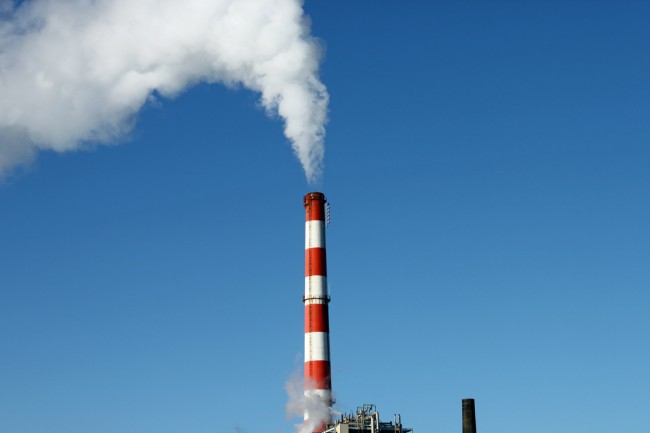
This is a close-up of the Antenna:
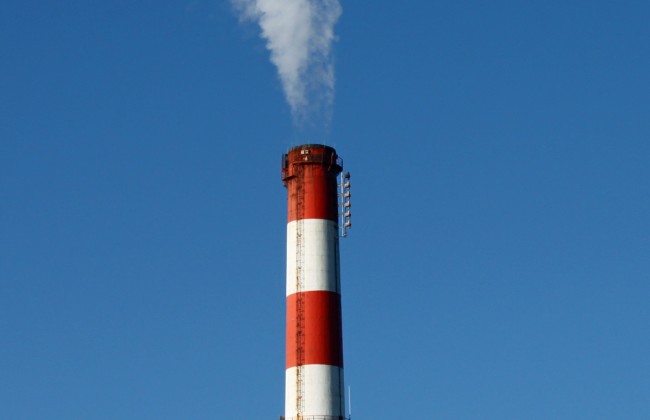
Here is an even closer view from a different angle:
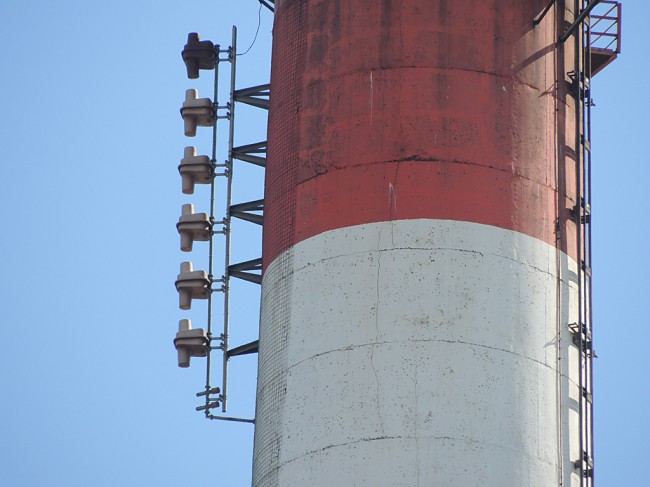
From this angle, one can see the mounting brackets and the wire mesh reflector installed on the smoke stack. From the first picture, one can see that the 400 MW PSEG coal fired power plant puts out a lot of combustion products when on line. Combustion is an exothermic chemical reaction that looks like this:
Hydrocarbon Fuel + Oxidizer + Nitrogen → Heat + CO2 + H2O + NOx
Included in this are any trace elements that are found naturally in the coal that is being burned. These include things like Mercury, Nickel, Uranium, et cetera. These trace elements can concentrate around the smoke stack because they fall out of the particulate quickly and these plants burn a lot of coal. The above picture was taken on a very cold day, most of what is coming out of the smoke stack is steam.
The issue for the radio station is when the particulate matter accumulates on the antenna, effectively shorting it out. The solution was to place the RADOMES around the elements and then constantly purge the RADOMES with nitrogen. Thus, this liquid N2 tank is vital for the operation of the radio station:
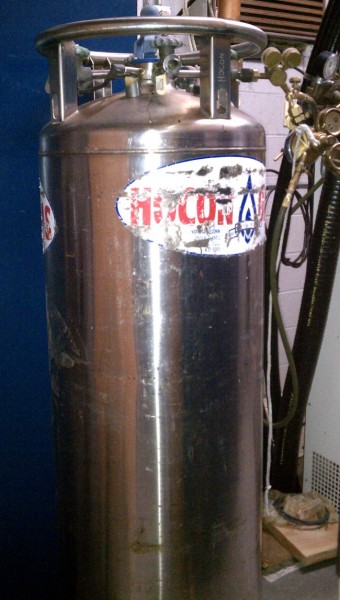
Each element of the antenna has a small hole in the feed line. N2 is fed continuously into the transmission line at a pressure of about 1.5 inches water column which then purges the RADOMES keeping any combustion products out of the RADOMES. The N2 tank needs to be changed out every 18-21 days and weights over 650 pounds when full.


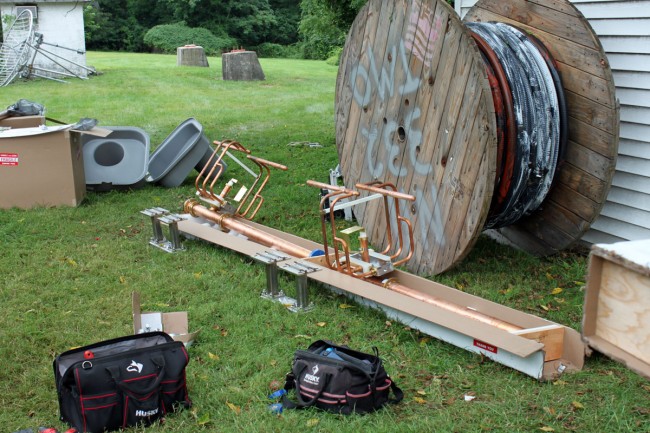
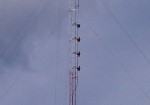
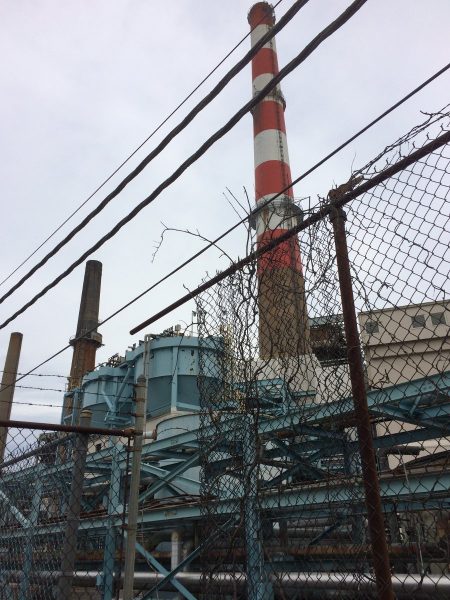
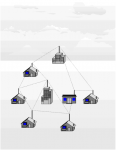
And of course that nitrogen tank is securely chained to the wall so it can’t fall over, break the valve off, and become a missile.
The former engineer had told me those radomes had to be custom made by the manufacturer for this purpose. Is the old top radome still in the side room there at the transmitter? He showed me the hole where they thought lighting struck the radome.
I see the ladder is on the opposite side of the array. How is the array serviced?
Bill
what’s the cost of refilling that tank every 21 days?
Perhaps it’s a trade-out?
I love your posts. It’s something that we don’t get to see everyday. Thanks for all your hard work.
Possibly a nitrogen generator doesn’t have enough volume for this application? Long term cost versus the tank might be attractive.
Wow. I suppose the usual dehydrator doesn’t have good enough filtering to avoid the particulates, either. But that can’t be cheap.
Without giving away any business practices of our clients, the N2 tank is quite expensive and it is not done on trade. The problem is, there is simply no other structure that all in the area to mount an antenna on. The station puts out a huge signal and does very well in the ratings and revenue.
Mike, we cleaned up all the stuff “stored” outside the transmitter building before we installed the new AC units.
That “tank” containing LN2 is called a Dewar. Liquid nitrogen by itself is nasty stuff requiring safety gear including cryo gloves and you need to convert it to a gas to be useful in our line of work. The dewar is fitted with a vaporizer for this purpose. Dewars are quite common at high power RF sites. We used to rent them all the time when I was a UHF TV chief since the ordinary “T” size tanks of N2 just don’t cut it when you are trying to purge 1,000 feet of 10-inch hard line. You would go through a truck load of them in a hurry.
Thanks Paul,
That’s all I really wanted to know since it’s a bit unusual.
I can’t recall why they gave up a site they had at an old navigation beacon site on a hill many years ago,do you?
My Broadcasting Yearbooks are long gone for technical comparison.
Jim, you are correct, the actual name is a Dewar. They are interesting in that there are several different connections on the top of them; gas, liquid, fill port, etc. Each has a different fitting so it would be difficult to connect a gas line to the liquid port, for example.
There was also the time that the gas company showed up with the wrong tank. We rolled it into the building and I was getting ready to hook it up went I noticed it said “Oxygen” on the tank. I shudder to think of what might have happened had I hooked up a tank of pure oxygen to an active transmission line running 34.5 KW.
Elliot, They moved from that site because the tower was short and in a residential neighborhood. I think they went up in power from 20 KW to 50 KW ERP at the same time. This all happened in the early/mid 1980’s.
Interesting to note that despite Nitrogen gas making up something like 78% of the Earth’s atmosphere, it is deadly stuff if you inhale it in pure form. Immersing creatures in an anoxic environment of inert gas is a method used for killing poultry. Immersing humans in an atmosphere of pure nitrogen has drawn the interest of Euthanasia groups, and has actually been suggested as a humane form of legal execution because people become unconscious almost instantaneously and there no traumatic side effects such as gasping as seen in other kinds of asphyxia. It has also been documented as a chosen method of suicide. There have been instances of people working on industrial equipment getting a whiff of a nitrogen cloud and simply falling forward into unconsciousness. There’s the old warning about working in a well ventilated room!
@Elliot / @Paul: Being the webmaster of the Westport Connecticut Radio tribute site and having been involved with the stations in one way or another I could give you some background that might be of interest. When Donald Flamm sold what was then WDJF in 1984 he retained the tower and property where the transmitter operated in Wilton. I believe the fact that the tower had been a sore point with the surrounding neighbors probably helped convince the new owners to move the transmitter. If I recall correctly they were operating a Collins rig prior to the move where the BE’s are presently.
I remember the original antenna on the stack either being a two or three bay antenna and back when I was chief of WMMM-AM, WDJF’s former sister station. It was around 1988-89(?) when it was replaced and the original 6 bay fell to the ground during install. If I remember correctly they station operated with a makeshift dipole until the hardline flange was repaired and antenna resurrected.
Thanks again Paul/Bill.
The site might also have been a navagation marker,something was said to be “spinning” up on that hill.
Yes,they went to 50 KW ERP with The present BE 25 KW units with the relocation,a well known fact.
BE’s are great and it’s a testament that Paul has helped keep these babies alive,at full power and sounding sweet all this time,kudos!
Bill,thanks for filling in with your first hand knowledge,really.
I just wanted to end with a moment of acknowledgement for Curt Hanssen,a major part of the creation of the first and perhaps present operation.
I hear he left us for the the big transmitter in the sky last weel,God bless him and all our heroes of communications.
If I had stayed in the states a few more years,I might have had a chance to meet many of you on some hill at some point.
Elliot
@Elliot: I believe you’re correct as while I have yet to add more pictures on the tribute website the building at the old transmitter facility had a round roof which I believe accommodated a beacon system of some sort. I know there were hiccups with those BE’s, from what I was told, they were modified for more power to accommodate the long length of hardline as the fact there were only a few bays up on the stack. If I’m not mistaken I think one of the power supplies suffered trauma during the testing of the pair prior to the switchover. Being so close to the power station occasional burps would create its own situations. I remember seeing line surge protectors blown out and looking like a shotgun was fired at them. I believe more than a few 200 amp contactors were replaced as well. Paul might have access to info left by former engineers Ed, Chriss or Conrad that may depict some of the hard life that site’s been through.
I was quite saddened to hear of the passing of Curt Hansen as well. He always treated me fair and always welcomed me when I visited the station. He was quite an air talent and truly responsible for turning the station around. Sadly, the station is only a shell of what it once was. We lost a legendary station when the corporate bigwigs in Atlanta took programming decisions out of the hands of the local staff. Just another empty preset in the car, now.
@Elliot E. (and anyone else) You can find the Broadcasting Yearbooks online dating back to 1935 here.
http://www.americanradiohistory.com/Broadcasting_Yearbook_Summary_of_Editions_Page.htm
I worked at WMMM AM&FM from 1969-1971. They acquired the 20kw Collins in 1971. Chief engineer Clif Mills and their consulting engineer Hillis Holt got it running but there were problems as the transmitter was quite new then. I managed to get it up to 20kw one Sunday morning but as they weren’t licensed to go that high just yet, that didn’t last long.
I believe the round building in Wilton was a VOR transmitter site for local airports (Bridgeport, Danbury, Westchester). The round flat roof was necessary for the “rotating” field that lets VOR receivers determine the direction to or from the antenna.
I did some work in Wilton one evening for Mike Fast, but personality clashes put a quick end to further employment.
@Bob M: Thanks for the background on the Wilton site. I wished I snapped pictures back when I was tending to the site for Gary Flamm after the FM was relocated. The last time I was up there it was loaded with two-wayy communications gear and nothing left to suggest the site’s former history.
Your info also confirms they likely had the same Collins rig up until the sale and move of the site. Somewhere in my files I have a copy of the license prior to the sale and it cited a Collins transmitter. I also forgot about Hillis Holt being their consultant – I’ll have to add that detail to the site when I do another update.
Does that big hunk of smoke-filled concrete behind the antenna affect the pattern?
@spinetingler: If you visit the WEBE108 Alumni Photo page on Facebook you’ll notice that the 6 bay directional antenna (which was a condition of the 1984 purchase (as the new owners also owned stations on Long Island) has a metal screen against the smokestack. I don’t have the background on the reason for the screen but I wonder if that was more for the directional properties of the antenna
On the same Alumni photo pages are a couple of pictures of the former Wilton transmitter site complete with circular roof, which was mentioned earlier.
Thanks, Bill. RIP Curt
Franz Alina was the owner of WEBE and also owned WBAB in Long Island. Vince Cremona was the GM, Conrad Trautmann was the Chief Engineer. They wanted to move the site for a better signal, and Booth Hill couldn’t handle the load at the time. This site was chosen. At the time, a 4 bay directional ERI antenna was installed on the smokestack, and parasitic reflectors were installed to the South side behind the 4 bay to reduce the signal level towards WBAB, as the rules were different then regarding signals and ownership. A study was also done on the metal reinforcements of the smokestack to best reduce the signal towards WBAB. A BE 35 KW was the transmitter. The studios were located in Norwalk, and an STL was mounted down at the level of the second white stripe from the top of the smokestack, aimed to the West. It was a paraflector (950 mHz) and had to be replaced quite often due to the contaminates from the plant. The transmitter shack was located on an adjacent property to the United Illuminating Harbor Station power plant, and the transmission line, and STL coax was run down the stack and underground through a conduit to the shack.
When the site was powered up, we encountered something not expected. The signal was totally legal, but most homes then had outdoor antennas for receiving television over the air from NYC. Many had pre-amps also. THe strong signal of 107.9 overloaded the front ends of the televisions and preamps within a mile of the transmitter site, and people were hearing the sound of WEBE on WNET-TV (PBS-NYC) instead. This resulted in visiting the homes of over 700 people, installing trap filters either in line at the television or in front of the preamp.
A few years later, to reduce cost of operation, it was decided to install a 6 bay(more gain, less power) and the incident occurred where the 4bay coming down hit the 6bay on the ground. Not sure of these details, as I only heard about the problem while working elsewhere. Yes, there were problems with the BE 35 Kw transmitter, and field modifications were needed by the factory rep’s to get it to keep running.
Back when I was chief of WICC WEBE I noticed and speaking with BE the final sections of both FM 35A’s were under size for the power the transmitters were running at which at the time was 35KW. BE upgraded both transmitters to current spec’s free of charge.
This would make the transmitters more stable and cut down on the arching between the tube chimney and the tuning bellows.
But what really helped was changing over to better quality air filters pleated filters in this case which took care of about 99%
of arching. I do also remember the 3X5 file card cabinet of TV interference complaints which I would still get calls
from people who would hear WEBE 108 instead of channel 13 audio. all in all it was an effort for me in my 21 years
as chief to keep it on the air as not much money was spent in the way of Engineering. I would think by now
they should think about replacing the BE’s
@Frank: Thanks for the additional background. From what I was told was supposedly the tower riggers from Dallas attempted to haul the new 6 bay up the stack after the 4 bay was removed and the rope broke. The story was that the riggers picked up and left after creating an OSHA incident by dropping the antenna on the power company’s property. This occurred after Chris Tobin and I finished doing transmitter/studio engineering respectively and Chriss Shearer assumed the duties of chief. He had called me in a panic about what to do and I suggested grabbing a bay from the abandoned antenna from the Wilton site (I was overseeing it for the Flamms at the time) and attempt to utilize it as a stopgap. Somebody decided to use a dipole as a temporary antenna. The signal could barely be heard over in neighboring Stratford and was unlistenable at the Norwalk studios. FYI: I was sent on a few TVI calls as well during my time there and had to install traps for people with outdoor antennas.
@Ed b: There’s no disputing that you did a yeoman’s job of keeping that place going in spite of the owner’s lack of investment in the infrastructure. It would not surprise me if the only way those transmitters get replaced is due to a catastrophic failure.
I’ve driven past this site 100’s of times, and looking at these pictures again brought a thought back in my head: Is the non-directional signal intentionally directionalized by the screen behind the antennas? Seems like a giant reflector to me. Would make sense to push it inland instead of over the sound.
Was a pattern study ever done on the smokestack antenna?
I was chief engineer of WMMM / WDJF from 1981 – 1983, after getting my BSEE from RPI. I grew up near the WMMM AM site in Norwalk and had started working there in 1974 while still in high school, installing ground radials and helping out on AM RF proofs. The radio bug bit – got my first phone as a senior in high school.
Frank, I did dozens of house calls around the Wilton site to install RF traps – same channel 13 issue!
Regarding WDJF’s operating power from Wilton, it was indeed 50 KW ERP from day one. Licensed TPO (20 KW Collins TX) was around 16.4 KW into ~120′ of Heliax to a Dielectric 6 bay antenna that occupied the top portion of the short 100′ tower – antenna gain around 5 or 6 dB. I did some upgrades at the site including replacing the FM coax – no hot spots and low reflected power the whole time.
The lower power story perhaps arose from a realization near sale closing to Franz’s group that the Collins TX could not make the full 20 KW it was rated for. We traced that to low voltage on power mains and re-tapped the plate transformer to compensate – that fixed it. Irregardless, the station always made its full licensed power of 50 KW.
During my tenure I also added Mosely PCL606 Composite STL’s in a double hop arrangement from studio to AM, relayed to FM, since there was no direct path between downtown Westport and Wilton. Used an Optimod 8100A at the studio.
Wilton had a backup CCA 20 KW TX at the time, with a Dielectric 4 port tranfer switch to antenna, with unused TX on a 20 KW water cooled dummy load.
The coverage issues from Wilton were a result of the short tower and, of course, hilly terrain throughout Fairfield county. We were exploring a site move well before the station was sold but the only “simple” option was Booth Hill in Trumbull – that was ruled out due to the high lease cost.
Franz offered me the CE job before the station sale closed but I declined – was interested in grad school instead. Many fond memories from those days but have moved on from broadcasting – though fun to look back.